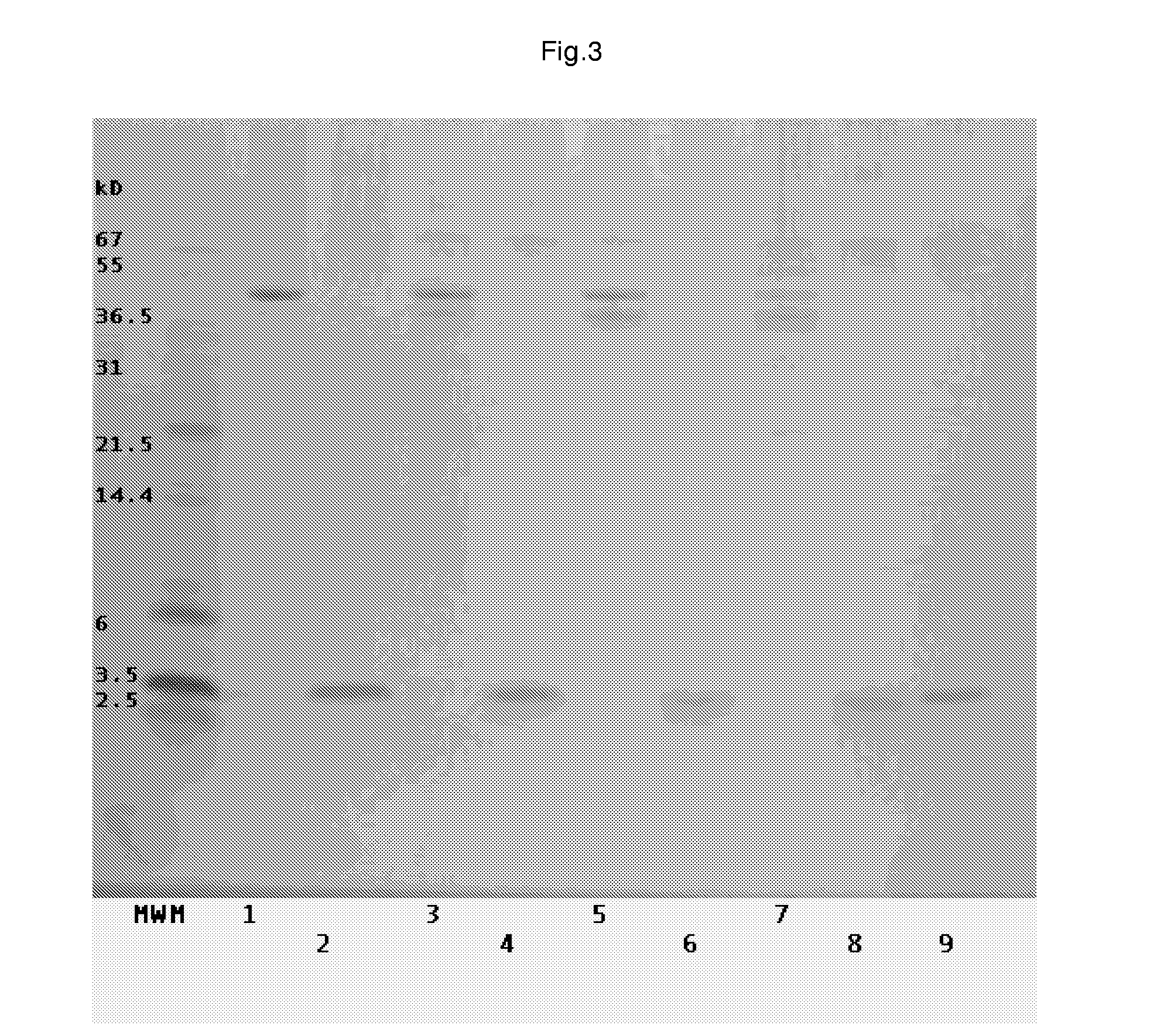Blood Pressure Lowering Protein Hydrolysates
a technology of blood pressure lowering protein and hydrolysate, which is applied in the direction of peptide/protein ingredients, drug compositions, peptides, etc., can solve the problems of prevalent risk factors for cardiovascular diseases, kidney failure and strok
- Summary
- Abstract
- Description
- Claims
- Application Information
AI Technical Summary
Benefits of technology
Problems solved by technology
Method used
Image
Examples
example 1
The Enzyme as Obtained from A. niger Represents a New Class of Proline Specific Enzymes
[0074]From the entire coding sequence of the A. niger derived proline specific endoprotease as provided in WO 02 / 45524 a protein sequence of 526 amino acids can be determined. The novelty of the enzyme was confirmed by BLAST searches of databases such as SwissProt, PIR and trEMBL. To our surprise, no clear homology could be detected between the A. niger enzyme and the known prolyl oligopeptidases. Closer inspection of the amino acid sequence, however, revealed low but significant homology to Pro-X carboxypeptidases (EC3.4.16.2), dipeptidyl aminopeptidases I (EC3.4.14.2), and thymus specific serine protease. All of these enzymes have been assigned to family S28 of serine peptidases. Also the GxSYxG configuration around the active site serine is conserved between these enzymes and the A. niger derived endoprotease. Additionally, members of family S28 have an acidic pH optimum, have specificity for c...
example 2
The pH and Temperature Optima of the Proline Specific Endoprotease as Obtained from A. niger
[0075]To establish the pH optimum of the A. niger derived proline specific endoprotease, buffers with different pH values were prepared. Buffers of pH 4.0-4.5-4.8-5.0-5.5 and 6.0 were made using 0.05 mol / l Na-acetate and 0.02 M CaCl2; buffers of pH 7.0 and 8.0 were made using 0.05 M Tris / HCl buffers containing 0.02 M CaCl2. The pH values were adjusted using acetic acid and HCl respectively. The chromogenic synthetic peptide Z-Gly-Pro-pNA was used as the substrate. The buffer solution, the substrate solution and the prolyl endoprotease pre-dilution (in an activity of 0.1 U / mL), were heated to exactly 37.0° C. in a waterbath. After mixing the reaction was followed spectrophotometrically at 405 nm at 37.0° C. for 3.5 min, measuring every 0.5 min. From the results shown in FIG. 1 it is clear that the A. niger derived proline specific endoprotease has a pH optimum around 4.
[0076]Also the temperat...
example 3
The Specificity and Purity of the A. niger Derived Proline Specific Endoprotease
[0077]Crude as well as chromatographically purified enzyme samples as obtained from an A. niger strain containing multiple copies of the expression cassette (cf WO 02 / 45524) were tested against a set of chromogenic peptide substrates to establish the specificity of the encoded endoprotease. Using different sets of chromogenic peptides the presence of possible contaminating enzyme activities was established. The endoproteolytic specificity of the encoded endoprotease was tested on different Ala-Ala-XpNA (AAXpNA) substrates. In this context “X” refers to the different natural amino acid residues and “pNA” to p-Nitroanilide. Cleavage of the peptide bond between the “X” residue and the pNA moiety of the molecule, causes a color change that can be monitored by an increase in the light absorbance at lambda=405 or 410 nm. The AAXpNA substrate. To that end stock solutions of AAX-pNA substrates (150 mmol / l) were ...
PUM
| Property | Measurement | Unit |
|---|---|---|
| Fraction | aaaaa | aaaaa |
| Fraction | aaaaa | aaaaa |
| Fraction | aaaaa | aaaaa |
Abstract
Description
Claims
Application Information
 Login to View More
Login to View More - R&D
- Intellectual Property
- Life Sciences
- Materials
- Tech Scout
- Unparalleled Data Quality
- Higher Quality Content
- 60% Fewer Hallucinations
Browse by: Latest US Patents, China's latest patents, Technical Efficacy Thesaurus, Application Domain, Technology Topic, Popular Technical Reports.
© 2025 PatSnap. All rights reserved.Legal|Privacy policy|Modern Slavery Act Transparency Statement|Sitemap|About US| Contact US: help@patsnap.com



